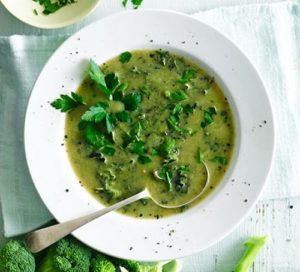

Have you heard of the secret to eternal youth? Yes, it has been discovered! Now, this isn’t just a point of vanity. This is for all those who want to live a good life. And by that, I mean a full life lived in ease, with energy, free of pain and with full mental capabilities all the way into our ripe old age –whatever that may be for each of us.
If this is your goal, then listen up!
The secret is intermittent fasting. Yes, grazing as we’ve been led to believe is not what our genetics are made for –we are not cattle and eating 3 meals a day with snacks in between does not do us well (1). This concept has received a lot of criticism and for good reason. I, myself was one of the harshest critics. As someone who for many years suffered from challenges with weight loss and who devoured every book and study on nutrition and weight-loss, I could not accept fasting as being healthy! The concept was a total paradigm shift in nutrition and everything I thought I knew about the workings of the human body. So, what caused my shift in mindset? Putting it into practice. And guess what, within a short few months, not only was I totally on board, I was recommending it to most my patients. And here’s why!
Intermittent fasting has been shown to benefit:
- Insulin sensitivity: reducing risk of Type II diabetes, Alzheimer’s disease (sometimes referred to as Type III diabetes) & lowering body fat (i.e. weight-loss)
- Inflammatory markers: improving inflammatory conditions like rheumatoid arthritis and improve autoimmune diseases like Crohn’s/Colitis, eczema, and others – through its modulation of immune factors.
- Memory and mood: Increases brain availability of feel good brain chemicals (serotonin, endogenous opioids and endocannabinoids) and promotes nerve regeneration which in essence results in improved memory and learning (2, 3).
- Heart health: reduces blood pressure, heart rate, cholesterol, and shown to improves survival after a heart attack event (4).
There’s no set protocol for intermittent fasting. Regardless of method however, intermittent fasting involves a period of time in which the body’s digestive system is given a break. This break allows the detoxification, repair and rejuvenation processes of the body to kick in. In order to reap the above-mentioned benefits of fasting however, you must ensure a minimum of 14 continuous hours. And so you may choose to skip a meal, fast a full day every other day, or follow a fasting diet every other week.
But isn’t fasting bad for you? And which plan should you follow?
Note that there are cases that may prohibit long-term fasting, such as with young children, pregnant and breastfeeding women, the elderly, type I diabetics (on insulin medication), or in cases of clinical myopathy (muscle wasting). As well, there’s some controversy regarding fasting for athletes and females trying to conceive; consider no more than 16 hours of overnight fasting a day until there’s more clarity in these cases.
What would an Intermittent fasting meal plan look like?
For some of us, the first step may simply be to try to experience what hunger feels like again and to stop prescribing to the grazing regiment of three meals a day with snacks in between. With that said, this is not meant to be a harsh starvation diet and although most foods negate the effects of fasting, there are foods that can be safely eaten without compromising your fast. These include fast assimilating nutrient-dense foods such as quality vegetable proteins, green vegetables and berries. It is also just as important to know how much to consume and how often.
Small servings (~100Kcal) of vegetable proteins (nuts, seeds & legumes), green vegetables and berries can be eaten every 3-6 hours when hungry. If you choose to, you can also incorporate one to two servings of a vegetable protein shake. I’d highly recommend this to those who have a difficulty in incorporating a fast assimilating (non-meat) complete protein throughout the day. So here’s what an intermittent fasting diet may look like:

Breakfast: A bullet proof coffee; handful of mixed nuts or ketone drink. More on why breakfast is NOT the most important meal of the day here .
Lunch: A salad of greens, berries & avocado Or a legume & veggie based soup
Dinner: This would be your ‘fast-breaking’ meal and you’re free to eat as you would normally.
OR
Ensure a period of 14 hours of fasting over-night by not eating solids for 16 hours. So, if dinner was at 7pm last night, taking into consideration that your body requires about 2 hours to digest your meal, 14 hours of fasting brings you to 11am for your first meal. And if you like to have a little snack later in the evening, say 9pm, delay your next meal until 1pm. Due to the functioning of our circadian rhythms (internal clock) which regulates all hormonal secretions, the best time for your largest meal of the day is dinner and so even if you’re breaking your fast at 11am, try and keep it light!
Now, let’s clarify a few things
There are many who believe that this form of eating can be more harmful than beneficial especially for females. The belief is that the stress of food restriction stresses the adrenal glands, causing a cascade of hormonal imbalances. In one such study, intermittent fasting was enforced on alternate days; 24 hours of no food followed by 24 hours free eating (5). The trouble is, Intermittent fasting diets vary vastly while there’s no set protocol or understanding of how long such intermittent periods should last. And so the vast difference in studies may be the root of the confusion and controversy surrounding intermittent fasting meal plans.
With that in mind, a regiment of no food for 16 hours daily is sufficient to reap the benefits of intermittent fasting without a consequential detriment to the adrenals –i.e. no need to fast for 24 hours! And this goes without saying that with a mindful awareness of your body, responding compassionately to its needs regardless of whatever ‘diet’ you may be following, you cannot go wrong! When starting out, be sure to take it slow, be mindful of potential drops in your blood sugar levels and remember that small servings of easily assimilated nutrients will not negate your fast. So, carry a handful of nuts in your pocket and have your protein shake nearby!
Whether your goal is weight-loss or simply optimizing your energy, memory and focus or needing to lower your blood sugar or cholesterol, intermittent fasting is so powerful that it deserves at the minimum a short-term trial. If you need further support, consider consulting with a knowledgeable health professional.

References:
1. Mattson, Mark P., et al. “Meal frequency and timing in health and disease.” Proceedings of the National Academy of Sciences, vol. 111, no. 47, 2014, pp. 16647–16653., doi:10.1073/pnas.1413965111.
2. Michalsen, Andreas. “Prolonged Fasting as a Method of Mood Enhancement in Chronic Pain Syndromes: A Review of Clinical Evidence and Mechanisms.” Current Pain and Headache Reports, vol. 14, no. 2, Oct. 2010, pp. 80–87., doi:10.1007/s11916-010-0104-z.
3. Hadem, Ibanylla Kynjai Hynniewta, et al. “Beneficial effects of dietary restriction in aging brain.” Journal of Chemical Neuroanatomy, 2017, doi:10.1016/j.jchemneu.2017.10.001.
4. Aly, S. (2014). Role of Intermittent Fasting on Improving Health and Reducing Diseases. International Journal of Health Sciences, 8(3), p.v-vi.
5. Martin, B., Pearson, M., Kebejian, L., Golden, E., Keselman, A., Bender, M., Carlson, O., Egan, J., Ladenheim, B., Cadet, J., Becker, K., Wood, W., Duffy, K., Vinayakumar, P., Maudsley, S. and Mattson, M. (2007). Sex-Dependent Metabolic, Neuroendocrine, and Cognitive Responses to Dietary Energy Restriction and Excess. Endocrinology, 148(9), pp.4318-4333.

